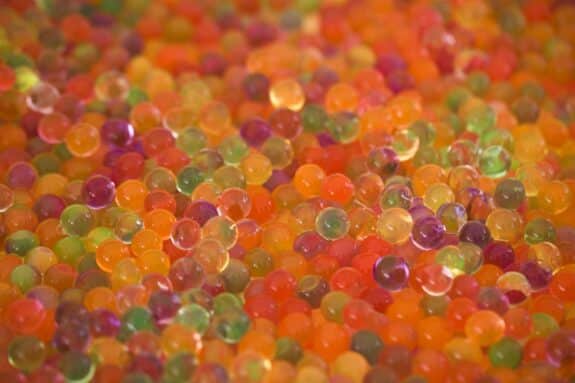Water bead toys, often marketed as sensory tools for children, have been linked to serious health risks that go beyond the well-documented risk of intestinal obstruction. A recent case study suggests that these small, gel-like beads could also pose a neurotoxic threat to young children who ingest them, raising concerns about their chemical composition and long-term effects.
A 13-month-old previously healthy female was admitted to the emergency department after experiencing prolonged vomiting, lethargy, insomnia, facial dermatitis, and significant weight loss. Ashley Haugen, an advocate from the nonprofit organization That Water Bead Lady and the mother of the affected child, reported that an exploratory laparotomy revealed a mass of water beads obstructing the child’s distal small intestine. The findings, published in Pediatrics, shed light on an emerging health hazard that extends beyond gastrointestinal complications.
Water Beads: Marketed for Sensory Play but Carrying Hidden Risks
Water beads are often sold as toys for young children and as therapeutic tools for children with autism and sensory processing disorders. However, their potential to expand significantly in size after absorption of liquid makes them particularly dangerous when swallowed. In a commentary accompanying the case study, Dr. Patrick Reeves and Dr. Eric Pasman of the Uniformed Services University of the Health Sciences in Bethesda, Maryland, emphasized the need for stronger consumer protections. They urged pediatricians to warn families about the dangers, particularly for children at higher risk due to age or developmental conditions.
“Without [pending] consumer protections, pediatrics should counsel families, including those at high risk based on age or developmental status, on the dangers of water bead ingestion,” they wrote. “There must be continued advocacy with the [Consumer Product Safety Commission] to mitigate the dangers posed by water beads.”
Growing Reports of Water Bead Injuries
Reports of water bead-related injuries have surged over the last decade, according to a systematic review presented at the American Academy of Pediatrics’ annual meeting. The American Medical Association House of Delegates has also highlighted the increasing number of injuries linked to these products.
In the case of Haugen’s child, her development was normal before ingesting the water beads. However, three months after the surgical removal of the mass, her health deteriorated, showing signs of neurotoxicity. Medical evaluations documented the following symptoms:
- Motor incoordination
- Tremors and muscle weakness
- Hypotonia (reduced muscle tone)
- Gait abnormalities
- Expressive and receptive language delays
- Sensory processing issues (difficulty tolerating temperature changes and resistance to touch on hands and feet)
- Delayed problem-solving skills
- Abnormal hearing
A brain MRI and chromosomal microarray ruled out structural or genetic causes, leading medical professionals to suspect acrylamide toxicity.
Acrylamide Exposure and Potential Neurotoxic Effects
The parents later confirmed that the water beads were made of polyacrylamide, a polymer that can release residual acrylamide monomers. Acrylamide is a known neurotoxin at high exposure levels, and the child’s developmental pediatrician made a presumptive diagnosis of encephalopathy associated with acrylamide toxicity.
By 20 months of age—six months post-surgery—the child’s developmental delays were evident:
- Gross motor skills: 18-month level
- Fine motor skills: 16-month level
- Receptive language skills: 10-month level
- Expressive language skills: 12-month level
At 22 months, a colon biopsy revealed mild eosinophilic inflammation and immune response indicators, suggesting prolonged exposure effects.
To address these challenges, the child underwent extensive therapy, including:
- Specialized skills training four times a month for fine motor and coordination issues (starting at 17 months)
- Speech therapy eight times a month (starting at 22 months)
- Low-dose sodium channel blocker (oxcarbazepine) to manage nerve hyperexcitability
At six years old, the child required daily speech therapy and special education services to support functional deficits. By age eight, significant progress allowed her to reduce speech therapy to twice per week.
The Need for Greater Awareness and Regulation
One of the key limitations of this case study was the absence of acrylamide blood level measurements, as such testing is typically available only in research settings. However, Haugen and her colleagues stressed that the significant delay between ingestion and medical intervention further complicated testing.
“This is an essential area for pediatric medical awareness because the dangers of water beads extend beyond what is commonly understood,” Haugen told MedPage Today. “While physical obstructions are often the focus, the potential chemical toxicity of water beads, including neurotoxic and systemic effects, has been largely overlooked.”
Since these beads can clump into gelatinous masses and may contain residual monomers, their long-term impact on digestive health and neurological development is a growing concern. The case study underscores the importance of recognizing both physical and chemical risks in pediatric evaluations.
Given the increasing number of reported cases, regulatory bodies and manufacturers must take action to improve labeling, warnings, and possibly restrict sales of water beads for child use. In the meantime, parents and caregivers should remain vigilant about keeping these toys out of reach of young children.
Related Articles:







